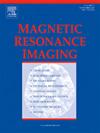儿童脑磁共振成像中神经网络合成图像的评价。
IF 2
4区 医学
Q2 RADIOLOGY, NUCLEAR MEDICINE & MEDICAL IMAGING
引用次数: 0
摘要
合成磁共振成像(SyMRI)是一种用于估计组织特性并从单个采集产生多个磁共振序列对比的技术。然而,图像质量可能不是最优的。目的:评估一种基于人工智能的多对比度加权图像直接对比度合成(AI-DCS)的神经网络方法,以提高图像质量。材料和方法:这项经IRB批准的前瞻性研究纳入了50名接受临床脑MRI的儿科患者。除标准护理(SOC)临床方案外,获得二维多延迟多回声(MDME)序列。采用35例患者的SOC 3D t1加权(T1W)、2D t2加权(T2W)和2D T2W流体衰减反演恢复(FLAIR)图像训练神经网络,生成合成T1W、T2W和FLAIR图像。定量分析灰质(GM)和白质(WM)表观信噪比(aSNR)和灰质(GWM)表观噪比(aCNR)。结果:对8例患者进行了评估。与SyMRI相比,T1W AI-DCS具有更好的整体图像质量,降低了噪声/伪影,并且在100 %(16/16)的评估中具有更好的主观信噪比。与SyMRI相比,T2W AI-DCS的整体图像质量和诊断置信度分别为93.8 %(15/16)和87.5 %(14/16)。与SyMRI相比,FLAIR AI-DCS在整体图像质量评估方面的得分为93.8 %(15/16),在噪声/伪像和主观信噪比评估方面的得分为100 %(16/16)。定量分析显示,与SyMRI相比,AI-DCS在T1W、T2W和FLAIR上的整体图像质量优于SyMRI (p )。本文章由计算机程序翻译,如有差异,请以英文原文为准。
Evaluation of synthetic images derived from a neural network in pediatric brain magnetic resonance imaging
Synthetic MRI (SyMRI) is a technique used to estimate tissue properties and generate multiple MR sequence contrasts from a single acquisition. However, image quality can be suboptimal.
Purpose
To evaluate a neural network approach using artificial intelligence-based direct contrast synthesis (AI-DCS) of the multi-contrast weighted images to improve image quality.
Materials and methods
This prospective, IRB approved study enrolled 50 pediatric patients undergoing clinical brain MRI. In addition to the standard of care (SOC) clinical protocol, 2D multi-delay multi-echo (MDME) sequence was obtained. SOC 3D T1-weighted (T1W), 2D T2-weighted (T2W) and 2D T2W fluid-attenuated inversion recovery (FLAIR) images from 35 patients were used to train a neural network generating synthetic T1W, T2W, and FLAIR images. Quantitative analysis of grey matter (GM) and white matter (WM) apparent signal to noise (aSNR) and grey-white matter (GWM) apparent contrast to noise (aCNR) ratios was performed.
Results
8 patients were evaluated. When compared to SyMRI, T1W AI-DCS had better overall image quality, reduced noise/artifacts, and better subjective SNR in 100 % (16/16) of evaluations. When compared to SyMRI, T2W AI-DCS overall image quality and diagnostic confidence was better in 93.8 % (15/16) and 87.5 % (14/16) of evaluations, respectively. When compared to SyMRI, FLAIR AI-DCS was better in 93.8 % (15/16) of evaluations in overall image quality and in 100 % (16/16) of evaluations for noise/artifacts and subjective SNR. Quantitative analysis revealed higher WM aSNR compared with SyMRI (p < 0.05) for T1W, T2W and FLAIR.
Conclusion
AI-DCS demonstrates better overall image quality than SyMRI on T1W, T2W and FLAIR.
求助全文
通过发布文献求助,成功后即可免费获取论文全文。
去求助
来源期刊

Magnetic resonance imaging
医学-核医学
CiteScore
4.70
自引率
4.00%
发文量
194
审稿时长
83 days
期刊介绍:
Magnetic Resonance Imaging (MRI) is the first international multidisciplinary journal encompassing physical, life, and clinical science investigations as they relate to the development and use of magnetic resonance imaging. MRI is dedicated to both basic research, technological innovation and applications, providing a single forum for communication among radiologists, physicists, chemists, biochemists, biologists, engineers, internists, pathologists, physiologists, computer scientists, and mathematicians.
 求助内容:
求助内容: 应助结果提醒方式:
应助结果提醒方式:


